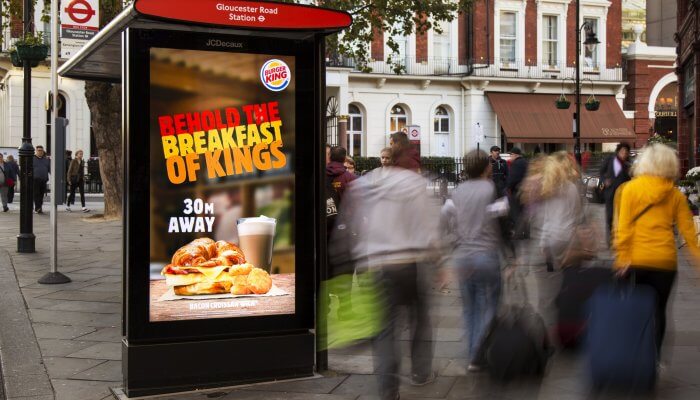Digital out of home, otherwise known as DOOH advertising, is proving to be an increasingly popular and effective tool for reaching target audiences on the move – driving brand awareness in public spaces, generating leads and spurring action from customers.
And it’s no wonder. 71% of Americans regularly look at roadside billboards – the type of OOH media that first springs to mind when we think of outdoor advertising.
However, according to some studies, OOH advertising at bus stations is even more effective at reaching target audiences, with bus station advertising reaching as much as 92% of the population every single week.
With these figures in mind, and as the global market for digital OOH continues to grow rapidly (expected to reach $35.1 billion by 2027, growing at a CAGR of 9.3% between 2020 and 2027), advertisers simply can’t afford to miss out on the fantastic opportunities bus station DOOH advertising offers.

(Image source: researchandmarkets.com)
So, what are the benefits of DOOH advertising at bus stations, and what types of OOH campaigns work best with this type of outlet?
How Effective Is Bus Station Advertising?
Digital bus station ads fall into the category of transit DOOH – a segment which also includes DOOH screens located on the inside of city and intercity buses and, according to the latest figures from Research and Markets, currently accounts for a 25.7% share of the global digital OOH market and expected to grow at a 9.1% CAGR between 2020 and 2027.
Digital ads at bus station displays are designed to reach travelers and commuters in a captive environment with high dwell times. As such, they are a highly effective form of outdoor advertising as they have great visibility in places where your eye-catching messages play to huge numbers of people each day whose senses are highly attuned to their environment as they wait for their bus.
The great thing about DOOH advertising at bus stations is that buses go where people go – making bus station advertising one of the most effective forms of OOH advertising (and why it accounts for over a quarter of the total DOOH market).
Due to high footfall and high dwell times, bus shelter advertising gets noticed by thousands of people every day.
What’s more, with today’s programmatic DOOH platforms you can utilize real-time location-based data to reveal where your target audience is most likely to be at specific times throughout the day
It’s never been easier for even small businesses to use bus station advertising to get their messages in front of the right people at the right place and time.
What Types of Digital OOH Campaign Work Best at Bus Stations?
Bus station digital OOH ads are particularly beneficial to SMBs that serve a regional community.
Local bus stations, of course, naturally draw commuters from the local area, as well as other travelers, such as shoppers or tourists who will either live or be staying in that area for extended periods of time.
This means, for one thing, that bus station advertising provides SMBs with a fantastic opportunity to drive brand awareness in their local area. More than this though, bus station ads that actually give directions to local businesses are extremely effective and can lead to increased sales at local outlets.
The Outdoor Advertising Association of America (OAAA) has figures that support this. In a recent study, the OAAA found that 51% of people notice DOOH ads that gave directions to a business. Of these, 65% immediately visited that business, and 92% of those made a purchase during the visit.
Utilizing programmatic DOOH platforms, advertisers can also gather key demographic data on the types of people that are using each bus station and also their movement patterns throughout the day. For example, in busy town or city centers, the people who regularly use public transport to commute to and from work are likely to be young professionals who travel at specific times of the day.
A powerful programmatic DOOH platform will give you detailed insight into the particular behavior of this target market, which, for instance, could be utilized by a local food outlet to promote its varying menu to commuters as they make their way to and home from work.

(Image source: google.com)
With campaigns like this, it’s possible to reach target consumers at a time and place they’re most likely to see and engage with a brand and the product it’s trying to sell. And of course, with digital bus shelter ads, it’s extremely simple to display changeable content at different times of the day.
This means our food outlet can advertise its breakfast menu in the morning, the lunch menu at lunchtime, and more substantial meals in the evenings.
Other types of advertisement that are particularly suited to bus station advertising are those that encourage mobile action and engagement.
With time to kill either on or waiting for a bus, travelers and commuters are looking for a distraction and something to do. This is a great opportunity to use creative messaging to encourage them to pull out their mobile phone and engage with your brand online.
The call to action may be to visit your website, use a hashtag on social media, activate a promotional offer with a special promo or QR code, or even, as ANZ demonstrates in the image below, download an app.

(Image source: google.com)
Get Started with Bus Station DOOH Advertising with a Powerful Programmatic DOOH Platform
Bus station advertising is a fantastic marketing option and opportunity, ideal for SMBs looking to build awareness with a large local audience, encourage action and increase sales.
It’s also great for businesses that want to target commuters and other regular users of public transport.
With The Neuron’s intuitive, easy-to-use and powerful programmatic DOOH platform, accessing premium outdoor media at bus stations has never been easier. With automated bidding, up-to-the-minute reporting features and ad display functionality, you can get started with bus station DOOH advertising in just a few clicks.


